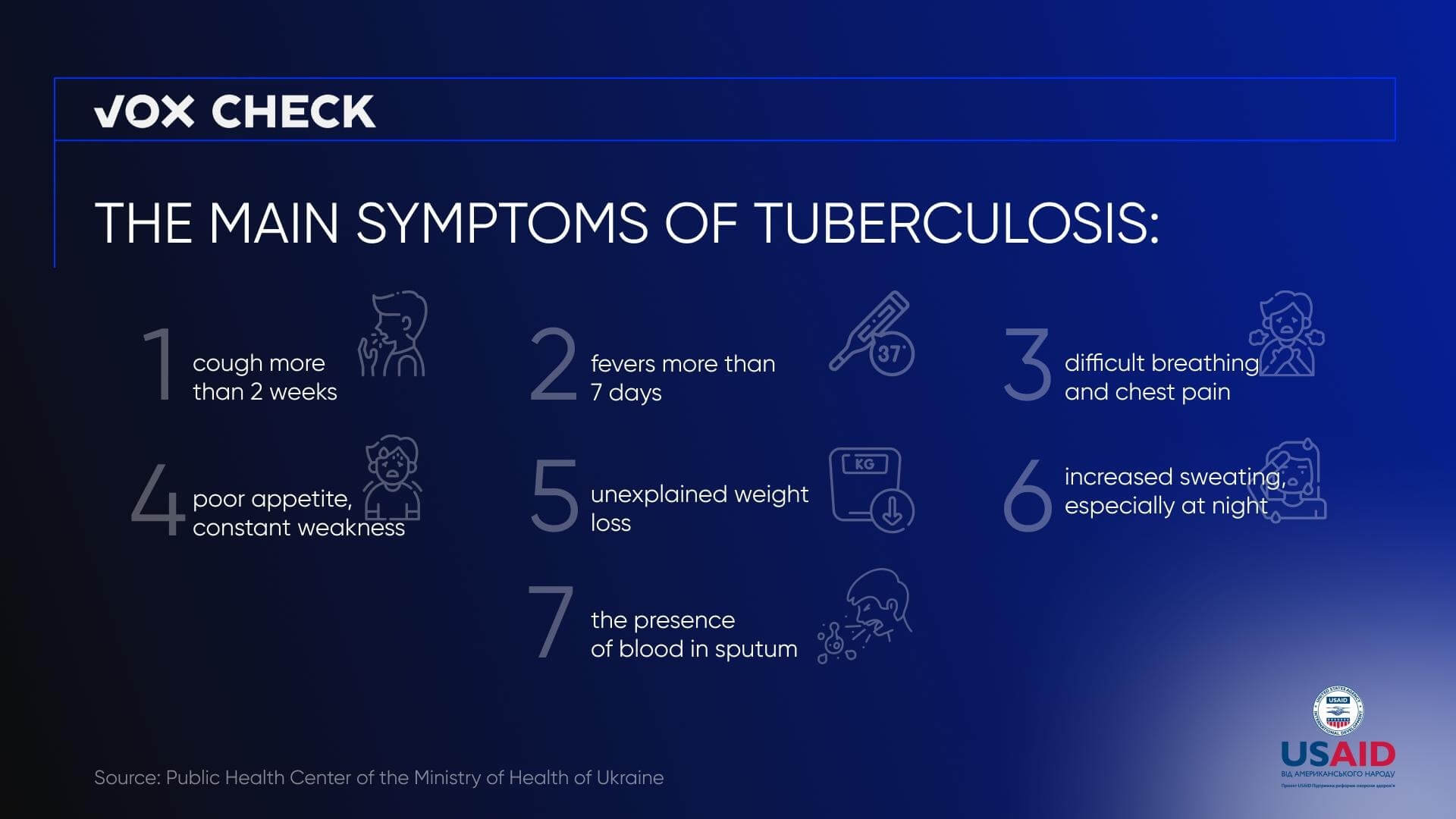VoxCheck continues to monitor propaganda throw-ins about the healthcare system of Ukraine. In this issue, we refute a fake about the difficult epidemiological situation with tuberculosis in Izium and the alleged inaction of the Ukrainian authorities. Also, after a short silence, the Russian media once again started talking about “American laboratories”: now they seem to have been moved from Ukraine to Poland and the Baltic countries.
With the support of the USAID Health Reform Support project, VoxCheck analyzes and refutes public health narratives spread in the information space of Ukraine, Belarus, and russia on a weekly basis.
Misinformation: Izium is under threat of the mass spread of tuberculosis
Information about the dissemination of tuberculosis in de-occupied Izium in the Kharkiv region is spreading in Russian and Ukrainian telegram channels. Russian sources also write that the city authorities do not carry out clearance from “Lepestok” mines and do not repair a central water supply.
Screenshot of publication
What’s the reality?
Volodymyr Matsokin, deputy mayor, commented on the situation with the incidence of tuberculosis in Izium. He explained that there is no threat of the mass spread of tuberculosis. Yes, residents of the city suffer from tuberculosis, but there is no threat of a massive increase in the number of patients.
More than 1,000 cases of tuberculosis, including relapses, are registered in Ukraine every month. Thus, in January 2022, 1 564 cases of tuberculosis were registered, and in January 2023 — 1 821 cases. In total, 11 551 people were treated from tuberculosis in January 2023.
Source: Public Health Center of the Ministry of Health of Ukraine
The director of the Izium Primary Healthcare Center, Yuliia Vrodzinska, told Suspilne Kharkiv in an interview that potential conditions for tuberculosis infection arose during the occupation of the city. People were sitting in basements, malnourished and stressed. In addition, the diagnosis of the disease was violated. In order to restore it, doctors turned to benefactors for the purchase of diagnostic drugs.
In some mass media, this information was distorted as if the city already had problems with the incidence of tuberculosis. However, preparing for possible challenges does not mean that the situation is already critical. Now it’s about prevention and prudence. The German charitable organization CAP ANAMUR helped to replenish the stocks of the diagnostic drug “Tuberculin” for conducting Mantoux tests. Stocks will be enough for at least half a year.
The manipulative conclusion that the city is not demined was made due to reports of injuries of teenagers from the explosion of a “Lepestok” mine at one of the city’s bus stops. One of the victims found a landmine in the village of Sulyihivka and decided to show it to his friends. However, demining works in the city and region were carried out continuously after the liberation of Izium in September 2022. For example, during the day of February 6, the pyrotechnic units of the State Emergency Service inspected 2,000 square meters of the territory of the region and neutralized 50 explosive objects.
Also, one notification about a temporary lack of water was provided as proof that the central water supply is not being restored in the city. In fact, it was temporarily absent not in the entire city but only in the “Upper Village” micro-district. The reason was damage by the Russians of power lines, which led to a lack of necessary power at the Bukinsk water intake. At first, residents were asked to prepare water supplies, and from January 27 to February 1, 2023, technical water was provided to the population by employees of the State Emergency Service.
Disinformation: The USA is moving biolaboratories from Ukraine to Poland and the Baltic countries
Russian media are spreading information that the US is moving biolaboratories from Ukraine to Poland and the Baltic states. The authors of the article also claim that Poland, together with American scientists, worked in Ukraine on the study of the rabies virus. In addition, the mass media quote the words of military microbiologist Mykhailo Supotnytskyi, saying that in the 1920s, Poland achieved great results in the development of bacteriological weapons.
What’s the reality?
Russian media actively spread the narrative about US biolaboratories in Ukraine, which were allegedly developing biological weapons components, even before the start of the full-scale invasion. Previously, we refuted fakes, as if in the US biolaboratory in Ukraine, it was studied how to infect Ukrainians with deadly viruses through mosquitoes, and American companies were conducting dangerous research on the Ebola virus in Odesa.
American secret laboratories for the development of biological weapons have never operated on the territory of Ukraine. Instead, cooperation with the US in preventing the spread of technologies, pathogens, and knowledge that could be used in the development of biological weapons took place at the official level. Thus, in 2005, the Ministry of Health of Ukraine concluded an agreement with the US Ministry of Defense, within the framework of which the US helped to modernize Ukrainian laboratories, conduct research, and increase safety culture to prevent outbreaks of dangerous infectious diseases. The Biological Threat Reduction Program clearly defines that Ukrainian biolaboratories are owned and controlled only by the Government of Ukraine.
The Soviet Union had its own biological weapons program, and after its collapse, dangerous biological materials remained on the territory of Ukraine. Therefore, the United States initiated a program to prevent the development of biological weapons. It operates in 27 countries of the world, including those that share borders with Russia: Georgia, Kazakhstan, and Azerbaijan. In addition, until 2014, this program covered Russian laboratories.
Following Russia’s accusations of developing biological weapons, ten countries that also cooperate in the Biological Threat Reduction Program have said that the project has purely peaceful purposes and has nothing to do with weapons.
No party has reported on the curtailment of the Biological Threat Reduction Program in Ukraine. Instead, in 2022, Ukrainian scientists took part in the Annual International Conference on Biosafety and Biosecurity as part of this initiative.
Back in 2020, the chief state sanitary doctor of Ukraine, Ihor Kuzin, explained that laboratories in Ukraine correspond to the second and third levels of biological protection and biosafety, and this level does not allow adequate and full work with particularly dangerous infections.
“Laboratories currently operating in the management system of the Ministry of Health, regional laboratory centers, our laboratory — are truly diagnostic laboratories. Considering the really small area of these laboratories, using them for some dual purposes is very difficult from a technological point of view,” noted Kuzin.
By the way, the highest class of laboratories in Poland is the third. Such laboratories are located in Podzamcze, Kraków, and Puławy. There are also no fourth-class laboratories in Lithuania, Estonia, or Latvia.
Also, Poland, Lithuania, Estonia, or Latvia are not included in the list of countries with which the US has cooperated within the framework of the Biological Threat Reduction Program. In addition, these countries, like Ukraine, signed the Convention on the Prohibition of the Development, Production, and Stockpiling of Bacteriological (Biological) and Toxin Weapons and on Their Destruction.
Although Poland was involved in the development of biological weapons in the 1930s, these studies were not so successful. As noted by Polish historian Andrzej Krajewski, who researched this topic by talking to eyewitnesses and studying archival documents, the Poles failed to create a biological weapon that could be used in military operations. While the Japanese have made considerable progress in this regard, creating bacteriological bombs, including the anthrax cluster bombs. However, Japan curtailed this activity after the end of World War II and, in 1972, also signed the Convention on the Prohibition of Biological Weapons.
Polish scientists, who are mentioned in the Russian media, conducted research on the rabies virus in Ukraine in order to trace the trend of the spread of the virus in different regions, that is, how many cases of the disease were recorded by Ukrainian laboratories during a certain period of time. The research was conducted by the Institute of Veterinary Medicine of the Warsaw University of Natural Sciences — the same institution mentioned in the Russian media — as well as scientists from Ukraine, the United States, and Switzerland. The results of the study were made public in 2021.
The head of the Polish Institute, Professor Marcin Bańbura, also noted that it is unwise to use the rabies virus as a biological weapon. Because it is transmitted only through a bite, microdamage of the skin, or mucous membranes. In comparison, it would be more effective to use viruses that are easily transmitted, for example, by airborne droplets.
This information piece was produced with the assistance of the United States Agency for International Development (USAID), provided on behalf of the people of the United States of America. This article’s content, which does not necessarily reflect the views of USAID, the United States Government, is the sole responsibility of Deloitte Consulting under contract #72012118C00001.
Attention
The authors do not work for, consult to, own shares in or receive funding from any company or organization that would benefit from this article, and have no relevant affiliations






